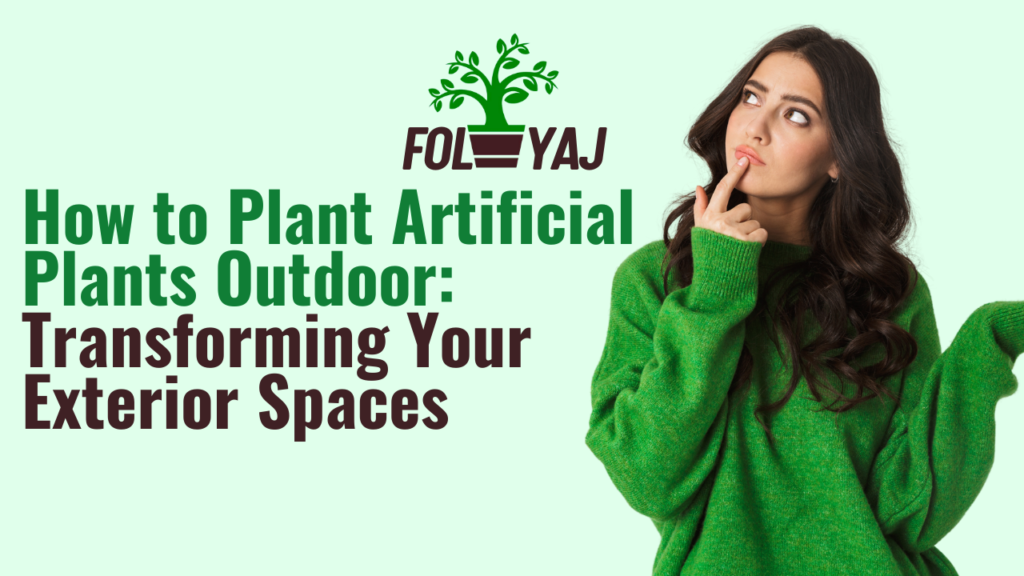In an era where time is precious and maintenance can be challenging, many homeowners and businesses are turning to artificial plants as a solution for outdoor landscaping. Learning how to plant artificial plants outdoor can revolutionize your approach to exterior design, offering a low-maintenance yet visually appealing alternative to natural flora. This comprehensive guide will walk you through the process, from selecting the right artificial plants to ensuring they withstand outdoor conditions.
The Appeal of Artificial Plants for Outdoor Spaces
Artificial plants have come a long way in recent years, with modern versions closely mimicking the look and feel of their living counterparts. When you Enhance your space with artificial tree decor, you’re not just adding greenery; you’re investing in a long-lasting, hassle-free solution that can transform your outdoor areas. Whether you’re looking to spruce up a small balcony or create a lush garden oasis, artificial plants offer versatility and durability that natural plants simply can’t match.
Benefits of Choosing Artificial Plants for Outdoor Use
- Low Maintenance: No watering, pruning, or fertilizing required
- Year-Round Beauty: Enjoy vibrant colors and full foliage regardless of the season
- Allergen-Free: Perfect for those with allergies or sensitivities
- Pest-Resistant: No need to worry about insects or plant diseases
- Versatility: Can be placed in areas where real plants struggle to thrive
Essential Steps for Planting Artificial Plants Outdoor
Selecting the Right Artificial Plants
The first step in mastering how to plant artificial plants outdoor is choosing the right products. Consider the following factors:
- Quality: Opt for high-quality artificial plants that can withstand outdoor conditions
- Realism: Look for plants with natural-looking textures and colors
- Size and Scale: Choose plants that fit proportionally in your outdoor space
- UV Resistance: Ensure the plants are treated to resist fading from sun exposure
- Weather Resistance: Select plants designed to withstand rain, wind, and temperature changes
For smaller spaces or to add accents to your outdoor decor, consider incorporating small plants for home decor into your design plan. These versatile pieces can add charm and character to any outdoor setting.
Preparing Your Outdoor Space
Before you begin planting your artificial plants, it’s crucial to prepare your outdoor area:
- Clean the Area: Remove any debris, weeds, or existing vegetation
- Plan Your Layout: Sketch out where you want to place your artificial plants
- Consider Lighting: Take note of sunny and shaded areas to ensure proper placement
- Assess Drainage: Ensure the area has proper drainage to prevent water accumulation
Techniques for Planting Artificial Plants Outdoor
Now that you’ve selected your plants and prepared the area, it’s time to dive into the actual process of how to plant artificial plants outdoor:
1. Digging the Hole
Even though artificial plants don’t need soil to grow, planting them in the ground can provide stability and a more natural look:
- Dig a hole slightly larger than the base of your artificial plant
- The depth should allow the plant to sit at the same level as it would if it were real
2. Securing the Plant
To ensure your artificial plants stay in place:
- Use a mixture of sand and small rocks at the bottom of the hole for drainage
- Insert the plant and fill the hole with a combination of soil and small rocks
- Tamp down the soil to secure the plant in place
3. Adding Finishing Touches
To make your artificial plants look more natural:
- Spread a layer of mulch or decorative rocks around the base
- Adjust the branches and leaves for a more organic appearance
- Consider adding real plants or elements nearby to blend the artificial with the natural
Maintaining Your Outdoor Artificial Plants
While artificial plants require significantly less maintenance than live plants, some care is still necessary to keep them looking their best:
- Regular Cleaning: Dust and rinse your plants periodically to remove dirt and debris
- Repositioning: Occasionally rotate or reposition your plants to prevent uneven fading
- Seasonal Checks: Inspect your plants at the change of seasons for any damage or wear
- Touch-Ups: Use UV-resistant spray to refresh faded areas if necessary
Creative Ideas for Incorporating Artificial Plants in Outdoor Spaces
Now that you’ve mastered the basics of how to plant artificial plants outdoor, consider these creative ideas to enhance your exterior design:
Vertical Gardens
Create stunning vertical gardens using artificial plants:
- Install a grid or trellis on a blank wall
- Attach artificial vines, ferns, and flowering plants
- Mix different textures and colors for a dynamic look
Poolside Paradise
Transform your pool area into a tropical oasis:
- Place large artificial palms and tropical plants around the pool
- Use artificial grass to create a lush, maintenance-free surround
- Add colorful artificial flowers for pops of vibrant color
Balcony Beautification
Even small spaces can benefit from artificial plants:
- Hang artificial trailing plants from railings
- Use tall artificial grasses or bamboo for privacy screens
- Create a cozy seating area surrounded by potted artificial plants
Seasonal Flexibility
One of the great advantages of artificial plants is the ability to change your outdoor decor with the seasons:
- Switch out flowering plants to match the current season
- Add artificial pumpkins and autumn leaves for fall
- Incorporate artificial pine trees and holly for winter
Overcoming Common Challenges
While artificial plants offer many benefits, there can be some challenges when planting them outdoors. Here are some common issues and how to address them:
Dealing with Extreme Weather
In areas with harsh weather conditions:
- Use heavier pots or secure plants more firmly in the ground
- Choose plants specifically designed for outdoor use
- Consider bringing particularly delicate pieces indoors during severe weather
Blending with Natural Elements
To create a seamless look between artificial and natural elements:
- Intersperse real plants among your artificial ones
- Use natural materials like rocks, wood, and water features
- Pay attention to the surrounding landscape and choose artificial plants that complement it
Addressing Skepticism
If you’re concerned about artificial plants looking “fake”:
- Invest in high-quality, realistic-looking plants
- Focus on proper placement and arrangement
- Combine artificial plants with real ones to create a more natural overall look
The Future of Outdoor Artificial Plants
As technology advances, the future of artificial plants for outdoor use looks promising:
- Improved materials that better mimic natural textures and movements
- Smart artificial plants that can change color or appearance based on weather or season
- Eco-friendly options made from recycled materials
Conclusion
Mastering how to plant artificial plants outdoor opens up a world of possibilities for creating beautiful, low-maintenance exterior spaces. By following the steps outlined in this guide, you can transform your outdoor areas into stunning, year-round displays that require minimal upkeep. Whether you’re looking to enhance a small balcony or create an expansive artificial garden, the versatility and durability of artificial plants make them an excellent choice for outdoor landscaping.
Remember, the key to success lies in selecting high-quality, realistic plants, properly securing them in your outdoor space, and maintaining them to ensure they continue to look their best year after year. With creativity and careful planning, you can create an outdoor oasis that combines the beauty of nature with the convenience of artificial plants. So why wait? Start planning your artificial plant outdoor project today and enjoy the benefits of a lush, evergreen landscape without the hassle of traditional gardening.



